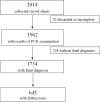The use of a pocket-sized ultrasound device improves physical examination: results of an in- and outpatient cohort study
- PMID: 25793296
- PMCID: PMC4368724
- DOI: 10.1371/journal.pone.0122181
The use of a pocket-sized ultrasound device improves physical examination: results of an in- and outpatient cohort study
Abstract
Background: The performance of pocket mobile ultrasound devices (PUDs) is comparable with that of standard ultrasonography, whereas the accuracy of a physical examination is often poor requiring further tests to assess diagnostic hypotheses. Adding the use of PUD to physical examination could lead to an incremental benefit.
Aim: We assessed whether the use of PUD in the context of physical examination can reduce the prescription of additional tests when used by physicians in different clinical settings.
Methods: We conducted a cohort impact study in four hospital medical wards, one gastroenterological outpatient clinic, and 90 general practices in the same geographical area. The study involved 135 physicians who used PUD, after a short predefined training course, to examine 1962 consecutive patients with one of 10 diagnostic hypotheses: ascites, pleural effusion, pericardial effusion, urinary retention, urinary stones, gallstones, biliary-duct dilation, splenomegaly, abdominal mass, abdominal aortic aneurysm. According to the physicians' judgment, PUD examination could rule out or in the diagnostic hypothesis or require further testing; the concordance with the final diagnosis was assessed. The main outcome was the proportion of cases in which additional tests were required after PUD. The PUD diagnostic accuracy was assessed in patients submitted to further testing.
Findings: The 1962 patients included 37% in-patients, 26% gastroenterology outpatients, 37% from general practices. Further testing after PUD examination was deemed unnecessary in 63%. Only 5% of patients with negative PUD not referred for further testing were classified false negatives with respect to the final diagnosis. In patients undergoing further tests, the sensitivity was 91%, and the specificity 83%.
Conclusions: After a simple and short training course, a PUD examination can be used in addition to a physical examination to improve the answer to ten common clinical questions concerning in- and outpatients, and can reduce the need for further testing.
Conflict of interest statement
Figures


References
-
- Kobal SL, Trento L, Baharami S, Tolstrup K, Naqvi TZ, Cercek B, et al. Comparison of effectiveness of hand-carried ultrasound to bedside cardiovascular physical examination. Am J Cardiol. 2005;96: 1002–1006. - PubMed
-
- Mc Gee SR. Evidence-based physical diagnosis Philadelphia, PA: WB Saunder Company; 2001.
Publication types
MeSH terms
LinkOut - more resources
Full Text Sources
Other Literature Sources
Medical

